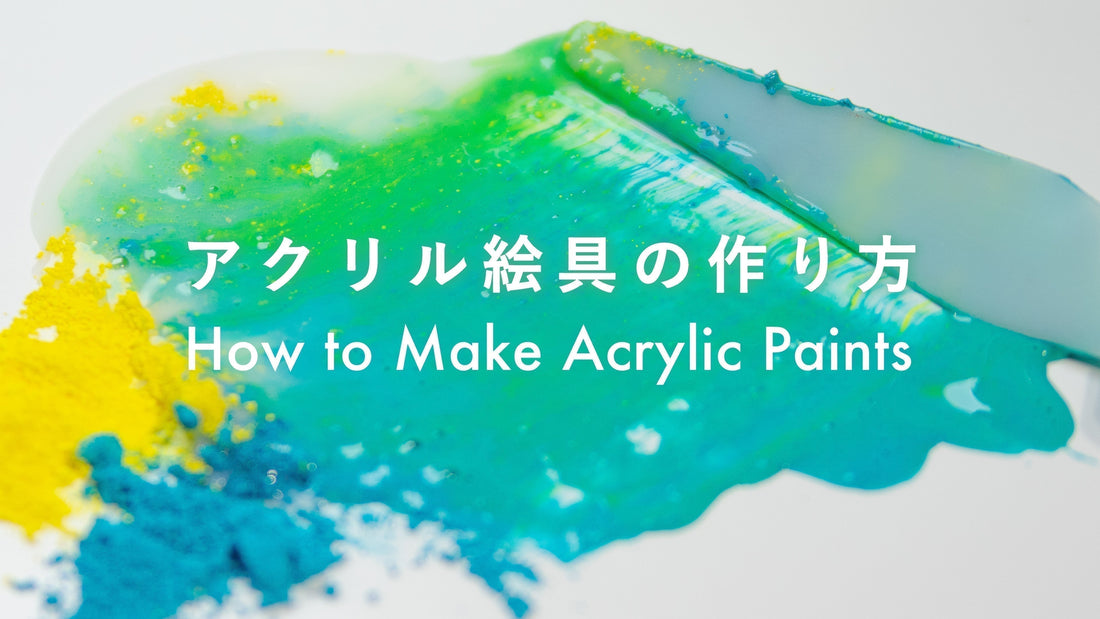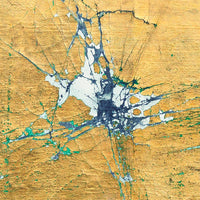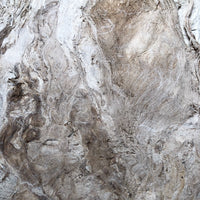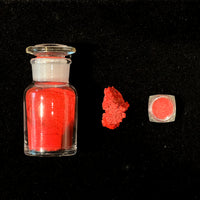Acrylic paint is a popular medium in art thanks to its vibrant color, quick-drying ability, and high durability.
It can be applied to a variety of surfaces, including paper, canvas, wood, and fabric, which makes it suitable for a wide range of applications, from paintings and sculptures to outdoor displays.
At PIGMENT TOKYO, we offer not only conventional paint tubes but also pigments and mediums (binders), allowing you to create your own colors and textures. This article introduces the basic materials and steps for making your own acrylic paint. It's designed to be beginner-friendly, so feel free to explore and discover your favorite colors!
What is Acrylic Paint?
Pigments are color powders that can only be used as paint when mixed with a binder (sometimes called a vehicle or medium).
To create acrylic paint, pigments are combined with a binder made from acrylic resin. This allows the paint to be mixed with water for application, and once dry, it forms a water-resistant film.
After hardening, this film cannot be dissolved again with water, making it suitable for both layering and flat applications. Moreover, the flexible film of acrylic paint allows for expressive thick strokes, while it can also be thinned with water to achieve a watercolor-like effect.
Easy Way to Make Acrylic Paints
Here's a simple method for those making acrylic paint for the first time.
Acrylic resin has strong binding power and can be mixed with a wide range of pigments. However, some colors may be challenging to blend due to their unique properties.
When selecting pigments, it is best to use finely ground pigments, as they ensure better compatibility with the binder. This results in acrylic paint with a smooth texture.
This article outlines the process and tools suitable for making small batches of paint using pigments.
Material
・Pigments
・Acrylic Emulsion
PIGMENT TOKYO's Acrylic Emulsion is an ideal binder for making acrylic paint.
Tools
・Paper Palette
・Painting Knife or Palette Knife
・Dispensing Spoon or Dining Spoon
・Cleaning Pot and Water
When making small amounts of acrylic paint, a paper palette and a painting knife are great tools to use. The white background of the paper palette makes it easy to see the colors and it's ideal for mixing. Moreover, its convenience lies in the ability to peel off each sheet individually.
How to Make
1. Place the Pigments on the Paper Palette
To prepare the paint making, start by placing the desired amount of pigment onto the paper palette. Use a spoon like a dispensing spoon to gather the pigment in the center. This will help prevent the pigment from scattering.
This time, we are working with the following pigment that contains fine particles.
2. Add Acrylic Emulsion
Next, add acrylic emulsion to the pigment.
A recommended mixing ratio is approximately 1:1 (binder to pigment).
Both hiding power and lightfastness can vary depending on the type of pigment and the amount of binder used. The key is to adjust the amount of binder according to the characteristics of the pigment.
For example, if the paint easily peels off the surface, add more emulsion to improve adhesion.
Moreover, keep in mind that adhesion also depends on the type of substrate being painted. It’s a good idea to test the paint beforehand to ensure its performance.

3. Blend the Mixture with a Painting Knife
Mix the pigment and acrylic emulsion using a painting knife.
To achieve a thorough blend, apply pressure to the knife's side against the palette and slide it across using the entire blade.
Continue mixing until the pigment is completely saturated with the binder, resulting in a wet and smooth paint without any streaks or lumps.
If the mixture looks powdery or lacks a sheen, gradually add more emulsion to adjust the consistency.

Note while working:
Acrylic paint can be diluted with water, but once dry, it cannot be re-dissolved. When mixing paint, ensure that the mixture does not dry out.
4. Ready to Paint
Test the paint on paper to check its color and texture.
You may adjust the paint's concentration by adding water.
If the paint doesn't go on smoothly or blend in well, please try adjusting it by adding acrylic emulsion.

For additional help, you might find our tutorial video below useful.
Having Trouble Mixing Pigment with the Binder?
Some fine-powdered or lightweight pigments may repel from the acrylic emulsion, making it difficult to achieve a uniform blend. In these situations, adding a few drops of a dispersant can help the pigment and binder combine more easily, resulting in a more consistent mixture.
Looking for an Easier and Faster Way to Make Paints?
Using a Pigment Paste or Mizuneri Paste made from pigment and water offers an easier way to blend original acrylic paints compared to the powdered pigments. When creating acrylic paint, mixing it with acrylic emulsion using the same method applied to powdered pigments results in paint with the same properties.
Pigment paste has a low viscosity and contains highly dispersed pigment particles, making it ideal for transparent washes and layered effects.
On the other hand, Mizuneri paste is slightly firmer and more resilient. It allows for easy adjustment of the quantity used and is available in a wide variety of colors. This paste is recommended for those looking to create thicker paint or who prioritize precise color mixing and tonal adjustments.
Mizuneri pastes and pigment pastes can be combined, allowing them to be used with binders other than acrylic emulsion.
| View Pigment Paste products |
| View Mizuneri Paste “sui-sai” products |
Differences in Color Based on Binders
The type of binder used can significantly alter the appearance of color, even when the same pigment is applied. Acrylic resin, for instance, provides excellent adhesion by firmly attaching the pigment to the surface. However, it coats the pigment particles, which can result in a slightly deeper "wet color" appearance compared to the pigment's original hue.
This color shift can also vary depending on the specific pigment being used. Therefore, it's important to experiment with actual painting to determine the combination that best achieves your desired expression.

The color sample of mixing pigment paste with different types of binders
Other than the acrylic resin, there are several types of water-based binders, each with distinct characteristics. Examples include gum arabic used in watercolor paints and nikawa (animal glue) used in Japanese painting.
Gum arabic can be re-dissolved in water even after drying, making it convenient for preserving homemade paints and allowing for repeated use.
On the other hand, animal glue is ideal for expressions that maintain the pigment's original hue and texture without altering its color or consistency.
To learn more about the characteristics of each binder, please refer to the following article.
For More Advanced Techniques:
Acrylic Emulsion + Mineral Pigments
By utilizing the high adhesive strength of acrylic emulsion, you can successfully incorporate coarse pigments into your artwork that are typically challenging to adhere to the substrate.
For example, mineral pigments used in Japanese painting can be mixed with acrylic emulsion to turn them into acrylic paint.
Mineral pigments are classified by particle size, with lower numbers indicating coarser particles. The unique characteristics of three-dimensional textures and the mineral sparkle that cannot be found in conventional tube paints add a distinctive charm to homemade acrylic paints.

【Art Materials Used】
Material:Shin-iwa Gunjo (No.6 / No.13)
Binder:Acrylic Emulsion
Acrylic Emulsion + Effect Pigments
By mixing with effect pigments, it is also possible to create original acrylic paints that incorporate visual effects such as light reflection and interference colors.
For more information on making paints using effect pigments, please check out the following article.
Acrylic Emulsion + Animal Glue + Pigments (Blending Two Types of Binders)
By blending different binders, you can go beyond simply adding to pigments and open up more creative possibilities.
For example, you can combine acrylic emulsion with animal glue to create a new binder that harnesses the properties of both materials, which can then be used to make paint.
It is also possible to mix it with water-soluble oil to create semi-oil-based paint. This allows you to achieve unique effects not found in commercial products. Therefore, it's advisable to research how to create your own original binders tailored to your work, based on each binder's adhesive strength and the resulting texture.
Acrylic Emulsion + Pigments + Extender Pigments
Conventional tube paints often contain both prime pigments and extender pigments, which help adjust the texture and viscosity, thereby enhancing the product's shelf life and usability.
By adding a small amount of calcium carbonate, a commonly used extender pigment, to homemade acrylic paint, you can compare how it affects the paint's flow, coloring effect and final finish. Experimenting with different material combinations can deepen your understanding of paint and potentially provide insights for expanding your artistic range.
Therefore, we invite you to explore unique color and medium formulations by making your own acrylic paints!












